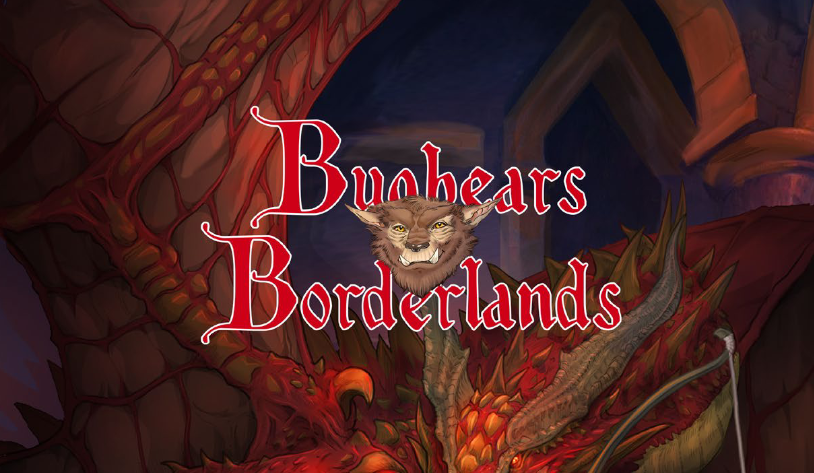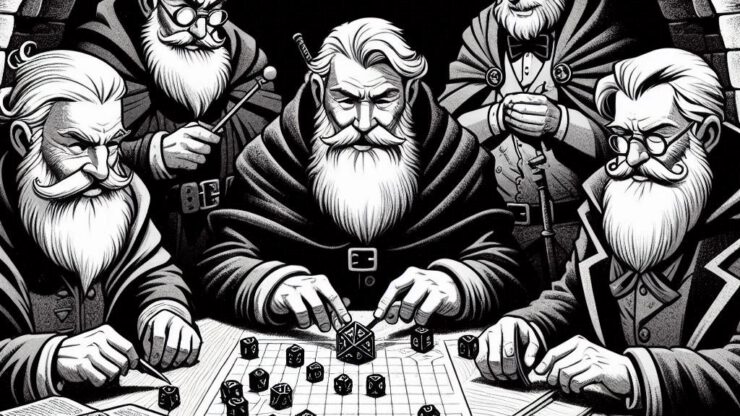I have a soft spot for the Old School Renaissance. Even though I never played original D&D or owned one of the Basic D&D boxes I have some quasi-nostalgic feelings toward this era of gaming. I like the simple mechanics which encourage the GM to make rulings and that player skill is more important than character stats. Over the years I’ve collected quite a few games which are direct simulacra of old editions of D&D or which are at least inspired by old-school D&D. Today I want to talk about three of those games.
Vagabond // Pulp Fantasy RPG

Let’s start with my current favorite: Vagabond. I stumbled upon it a couple of days ago when I was checking on what’s new on DriveThruRPG. Vagabond is an about 200-paged TTRPG compatible with B/X D&D but comes with a lot of exciting changes.
There’s a new and simple roll-over resolution system which includes simple skills. It’s written not only with regular group play, but also solo or co-op in mind. Vagabond’s (non-Vancian) magic system is brilliant and gives characters a lot of freedom on how to cast their spells. The core rules come with 6 ancestries and 18 classes. It takes inspirations from many popular TTRPGs like the aforementioned B/X, but also Dragonbane, Mörk Borg, ShadowDark and many more.
I especially like the extensive bestiary included. I could probably ramble on about how much I enjoyed reading Vagabond for hours. I highly recommend you to check it out. By the way, the author, Taron Pounds, is currently running a Kickstarter campaign to fund another print run. At the time of this writing the KS has already been fully funded but there are still over 50 hours to go. There’s also a free Basic rulebook containing four ancestries and six classes you can check out right now!
Bugbears & Borderlands

Bugbears & Borderlands is what happens when you use 5E’s mechanics and use them to create a more streamlined version inspired by B/X D&D. All the basic character races from D&D 5E are included, but there are only three classes: Fighter, Expert (basically B&B’s version of a thief/rogue) and Wizard.
The last class is the most exciting since it’s not your regular D&D wizard. For starters wizards in B&B can cast spells which are usually reserved for clerics as well as the familiar wizard spells. They also get to choose a “Magical Bond” at level 3 which has a huge impact on the character. For example the “draconic” bond grants the wizard draconic powers and changes their appearance into some kind of half-dragon while the “divine” bond turns them into warrior clerics and grants various weapon and armour proficiencies. I just wish they picked a better term than Wizard for the class.
B&B isn’t as innovative as Vagabond, but its take on the wizard class made it stand out for me. I also think that the author, Roderic Waibel, managed to achieve what he set out to do: to create a basic version of 5E inspired by the classics. Like Vagabond it comes with a full bestiary and the whole thing is even available for free. You can also get B&B in a POD format either as one softcover book or two hardcover books (Players and GM Guide).
Chromatic Dungeons

Chromatic Dungeon is another OSR D&D clone created by Roderic Waibel. It’s his attempt to combine an old-school gaming experience with more modern sensibilities and design philosophies. It actually managed to tick most of the boxes I had on my “the perfect D&D retro clone” list: ancestries and customisable heritages – check, ascending AC – check, d6-based thief skills – check, same level up XP requirements for all classes – check. It shares a lot with the aforementioned B&B, but its 5E influences aren’t as prominent and it looks and feels more like a game from that era. The layout is directly inspired by the AD&D core rules. Like with my other recommendations it comes with a full bestiary.
Chromatic Dungeons has received quite some flak from certain parts of the internet because inclusive representation was one of its design goals. Why this could be seen as a bad thing is beyond me. When compared with Bugbears & Borderlands I think that Chromatic Dungeons is the more flexible game of the two. B&B’s wizard class is so much different from what we are used to, that it has major effects on the implied setting. Chromatic Dungeons is in a way more “traditional” and thus can be more easily used.
One last thing: Chromatic Dungeon comes with a dyslexic-friendly PDF which uses a special font designed to help people with dyslexia.
Bonus: White Box Cyclopedia

The works of James M. Spahn are always easy recommendations. I don’t remember any of his releases which didn’t immediately excite me. His take on magic items in “The Hero’s Journey Fantasy Roleplaying” was totally brilliant and why other games didn’t steal the idea of magic weapons and armour acquiring magic properties by usage. But I digress.
The White Box Cyclopedia is pretty much what the D&D Cyclopedia was for BECMI but for White Box D&D. It includes the full White Box rules and all the races, classes and other additions to the game James’ has written over the years. But it’s more than a simple compilation. Everything has been double-checked and James made sure everything fits together perfectly. In essence you’re getting a smorgasbord of options from which you can pick.
I love James’ works, I love White Box, but there’s one catch: it’s not out yet. A while ago the White Box Cyclopedia was successfully funded on Kickstarter but unfortunately it’s still in layout. But it was promised to the backers that the PDF release is close. That’s why it’s “only” a bonus recommendation.
A few last words…
In this day and age it’s really hard for smaller games to stand out. We gamers usually tend to focus on the “big ones”. In the general RPG scene this is Dungeons & Dragons 5E. In the OSR it currently is ShadowDark. Before that Old-School Essentials was THE game everyone talked about. I think the games I mentioned in this article are not talked about enough. So please, check them out and if you like what you see, share the word. Thanks.

